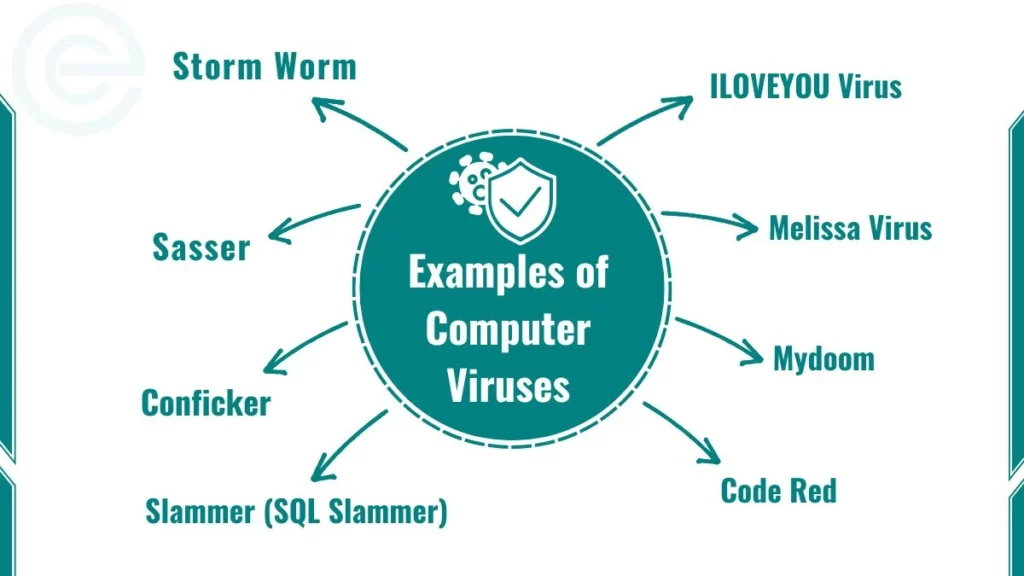Computer viruses examples include ILOVEYOU Virus, Melissa Virus, Mydoom, Code Red, Slammer (SQL Slammer), and more.
A computer virus is a big problem for everyone. These harmful programs can damage our computers, steal information, and cause much trouble. Let’s explore some examples of computer viruses that have left their mark on the digital landscape.
Computer Viruses Examples
Here is a list of computer viruses:

1. ILOVEYOU Virus
ILoveYou virus is a most common computer virus example. The ILOVEYOU worm also known as the Love Letter virus, spread faster than high school gossip in May 2000. In Japan, it was even dubbed ハートの虫 (Hāto no Mushi), which means “Love Bug.”
This sneaky virus arrived in emails with the subject line “ILOVEYOU” and an attachment that, when opened, sent copies of itself to everyone in the victim’s address book.
Fact: This virus caused $10 billion in damage around the world.
2. Melissa Virus
Melissa is an example of a computer virus because it spreads via infected Microsoft Word documents. This computer virus is attached to emails and replicates itself by sending copies to the first 50 contacts in a victim’s address book. This fast spreading is what makes it a virus.
Fact: Melissa led to $80 million in damages and slowed down many email systems.
3. Mydoom
The name says it all – doom and gloom! The Mydoom worm, sometimes called the Doom worm, spread like wildfire in 2004. Mydoom is like a virus because it’s one of the fastest-spreading email bugs ever. It sends itself as an email attachment and can make infected computers attack websites. It can also create secret entrances for hackers.
Fact: At one point, Mydoom was responsible for 25% of all emails sent worldwide.
4. Code Red
Code Red is a virus that attacks websites and changes their look to show the message “Hacked by Chinese!” It’s a virus because it makes copies of itself and causes unexpected problems on infected computers.
Fact: Code Red infected over 359,000 servers in less than a day.
5. Slammer (SQL Slammer)
Slammer was tiny but mighty. It targeted database software and spread so fast that it slowed down the entire internet. Slammer shows that size doesn’t matter when it comes to viruses even small ones can cause big problems. Slammer is a fast-moving bug that makes copies of itself and jumps to other computers. Even though it’s called a worm, it acts like a virus by copying itself.
Fact: Slammer infected 75,000 computers in just 10 minutes.
6. Blaster (MSBlast)
Blaster spread without needing anyone to click on anything. It got into computers through a Windows flaw and made them restart over and over. Blaster teaches us that automatic updates are important to fix security holes before viruses can use them.
Fact: Infected computers displayed a countdown to when they would shut down.
7. Conficker
Conficker spreads through shared folders on networks and takes advantage of a problem in Windows. It’s a virus because it makes copies of itself, can turn off security programs, and joins many computers together for bad activities.
Fact: Conficker infected millions of computers in 190 countries.
8. Sasser
Sasser attacked a part of Windows that let it spread without email or file sharing. It caused computers to crash and reboot, even affecting hospitals and airports. Sasser reminds us that viruses can put lives at risk when they disrupt important services.
Fact: Sasser crashed computers in critical places like hospitals and airports.
9. CryptoLocker
CryptoLocker locked up people’s files and demanded money to unlock them. This type of attack, called ransomware, shows how viruses have become a way for criminals to make money directly from victims. It spreads through email attachments and can copy itself across different computers and networks.
Fact: CryptoLocker earned criminals about $3 million.
10. Storm Worm
The Storm Worm used fake news stories to get people to click on links and install it. It built a large network of infected computers that criminals could use for attacks. Storm Worm reminds us to think twice before clicking on sensational headlines.
Fact: Storm Worm may have infected up to 50 million computers.
These 10 viruses are just a few of the many that have caused problems over the years. Each one is a lesson in why cybersecurity is so important. They show us that we need to:
- Be careful with emails and links
- Keep our software up-to-date
- Use strong passwords
- Back up our files
- Have good antivirus protection
